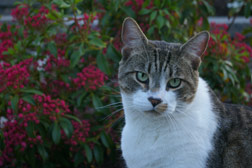Caring for Feral Cats
Caring for a colony of feral cats or just a new cat that has been visiting and appears homeless will dramatically improve their quality of life.

Spay/Neuter
The kindest and most important thing you can do for a feral cat is to ensure that he/she is spayed or neutered. See How to Trap-Neuter-Return Feral Cats and Low Cost Spay/Neuter Options.
Feeding
Feed the highest quality food you can afford. Try to avoid, if possible, ingredients such as any type of “byproducts” or those foods that have grains as one of its first ingredients. A high quality diet will keep the cats healthier. If you can’t afford a high quality prepared food, supplement the food you do buy with a little cooked hamburger – hamburger costs about the same as cat food. However, hamburger alone lacks calcium and should only be used as a supplement to their regular food.
Feeding stations
The best, and least expensive stations, are made out of a large plastic container with lid. Cut a large hole at one end and put the food in the other end. It will stay dry. If you find you are attracting too many wild animals, feed at a certain time each day and pick up the food once the cats have been given a chance to eat. Never leave food out overnight.
Water
Make sure the cats have fresh, clean water every day at the same time as the feeding. During the winter months they will know when to come to get their daily drink before the water freezes. Of course, if you can, it is much preferred to give fresh water twice a day. If your budget allows, purchase a heater for your water bowl.
Shelter

Cats need shelter to keep out of the rain and the cold. The least expensive and easiest shelter is made out of a large Tupperware container (54 gallon size). Cut a hole large enough for the cat to go through but not large enough for other animals like raccoons. Place it on a pallet or two to keep it off the ground as it will be warmer and less likely for snow to block the entrance. Stuff it with hay (lots of hay in the winter months). Place it, if possible, so the door is blocked from the wind.
Another option is to buy some bales of straw (much preferred over hay) and situate the bales in a way so that there is a hole in the middle with bales below, above and to the side of the hole.
Keep openings facing south, if possible, or facing in a direction that is partially protected by a building to keep the wind out.
You can provide your cat with extra warmth in the winter months by purchasing an item such as Snuggle Safe heat pad. It is a round disk that can be heated in the microwave for 5 minutes and will stay warm for many hours.
Be a good neighbor
- Keep your yard neat, don’t leave cat food cans, blankets and other debris lying around.
- If cats are using the neighbor’s yard for their litter box, place sand into a large Rubbermaid container and place it on your property and clean weekly. Or put some peat moss (about a 3’ X 3’ section) on the ground and change it once a month or so. Both options are very inexpensive.

